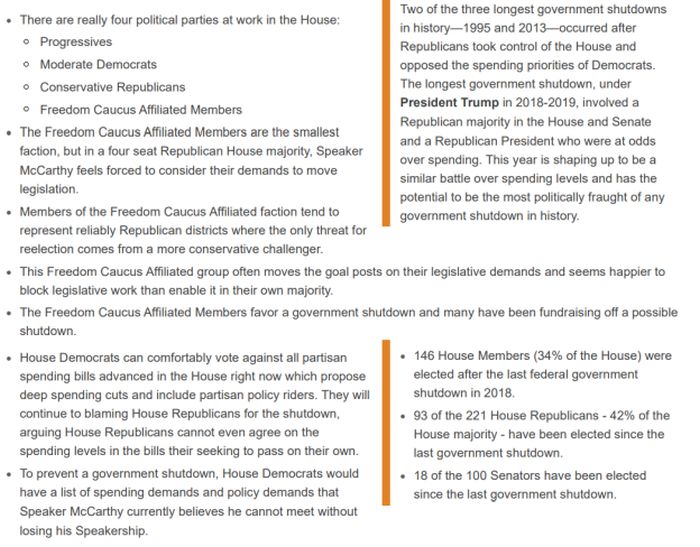The Arnold & Porter Legislative & Public Policy Group will send periodic updates on efforts to pass legislation to fund the federal government past September 30. We will share updates on relevant events in the House and Senate. Today's update is designed to provide a baseline understanding of which proposals are in play and what political considerations may impact the policy decisions under consideration in Congress and the White House.
We believe the likelihood of a federal government shutdown is high as both the House and Senate forge different paths to fund the government with no clear strategy to negotiate an agreement before midnight on Saturday, September 30.
What's At Stake
- Funding for the government will expire at midnight on Saturday triggering an immediate shutdown if there is no deal in place.
- House Speaker Kevin McCarthy (R-CA) is navigating a four-seat House majority in his chamber and any perceived misstep in handling the negotiations could cost him his leadership position.
- Public opinion polling to date is mixed on who would be blamed for a shutdown, but House Republicans and their 2024 Presidential nominee are currently more likely to take public blame than President Biden and Congressional Democrats.
How We Got Here
- Congress spent the spring and early summer narrowly avoiding a debt ceiling crisis, leading to a delay in passing annual appropriations bills before the start of the new federal Fiscal Year (FY) on October 1.
- The Fiscal Responsibility Act of 2023 (FRA) (P.L. 118-5) - became law on June 3 and set appropriation levels for FY 2024 and FY 2025.
- The White House and Congressional Democrats view the spending levels in the FRA as a floor on spending, and their preference for any stopgap funding measure to avert a shutdown would be to add: (1) emergency spending for domestic disaster relief in Hawaii, Vermont, and Florida; and (2) supplemental defense aid for Ukraine to the final spending bills for FY24.
- House Republicans view the spending levels in the FRA as a ceiling and have proposed FY24 appropriations bills cut spending by tens of billions of dollars under the amount President Biden and Speaker McCarthy negotiated in FRA, but they lack the votes in their own conference to pass appropriations bills that reduce spending.
Political Realities

- Thus, Speaker McCarthy is caught between the proverbial rock
and a hard place on FY 2024 federal spending levels.
- If the Speaker cuts spending level deals with the Freedom Caucus Affiliated Members, no House Democrats will vote for that legislation and, after (maybe) passing it through the House on the narrowest of partisan margins, it would be dead on arrival in the Senate.
- If the Speaker cuts a deal with House Democrats advancing a funding bill that does not include cuts in spending levels, even if palatable to the vast majority of House Republicans, the Freedom Caucus Affiliated Members and some more mainstream populist House Republicans promise to force a motion to vacate vote to remove the Speaker from his leadership post.
- Our conversations with relatively new Republican Senators and Representatives in both parties continue to demonstrate a lack of understanding about how painful the shutdown will quickly become for many of their constituents. These conversations lead us to believe the chances of a long initial shutdown - two weeks or more - are quite high.
Executive Branch Activity
- The White House is reminding House Republicans that the FRA set the spending limits for FY 24 and a deal should honor those funding levels.
- The President and his team are not actively involved in Congressional negotiations with House Republican leadership on any short-term Continuing Resolution (CR) to keep the government running in the short-term while a long-term funding deal is developed.
- Executive Branch agencies started issuing shutdown memos and providing furlough notices to employees who will be designated as non-essential, and identifying programs and payments that will be suspended during the duration of a shutdown.
- Below, we provide some resources for details on agencies impacted during a shutdown.
Senate Activity
- Because all federal funding bills must start in the House, the Senate is using a procedural maneuver to try and pass a CR to keep the federal government operating through mid-November, allowing time for Congress to continue negotiations towards a year-long spending agreement.
- The procedural maneuver includes taking the House-passed FAA reauthorization bill and adding the CR to it.
- On September 26, the Senate released a bipartisan CR that would fund the government through
November 17, 2023, and would:
- Extend authorization of the Federal Aviation Administration (FAA) until December 31, 2023.
- Sustain pay for federal firefighters helping to respond to natural disasters, including US$6 billion in emergency disaster relief funding.
- Provide supplemental military funding (US$6.1 billion) for Ukraine.
- Allow the Department of Education extra spending flexibility to manage the return to repayment for student loans, beginning on October 1.
- Extend authorizations of health care programs and ensure the Special Supplemental Nutrition Program for Women, Infants, and Children continues to serve those who rely on it.
- Provide pro-rated economic assistance funding for the Federated States of Micronesia (FSM) for the duration of a CR and continue to provide the FSM essential U.S. Federal programs and services after September 30.
- Note: We understand that anomalies with scoring implications (meaning net new additional spending) were off the table during discussions with Senate Republican leadership. As such, the number of additional policy provisions was quite limited in the Senate bipartisan CR.
- The Senate is working to clear a CR as soon as Friday, but Senator Rand Paul (R-KY) has objected to quickly moving any legislation that includes more supplemental funding for the war in Ukraine.
- Senator Paul is thus forcing Senate Majority Leader Chuck Schumer (D-NY) to jump through a number of timebased procedural steps to pass the bill.
- Beyond Senator Paul, there are several other Senators who object to the funding levels and supplemental spending proposed in the CR and are seeking to make changes to it this week.
- Some Senate Republicans, including Senator John Thune (R-SD), are also calling for up to US$6 billion in additional border wall funding, in order to make a Senate CR more palatable overall for House Republicans.
- While it is still very much in flux, the Senate may be considering removing Ukraine funding altogether from the CR it sends to the House.
- This could force the Senate to delay a vote until Sunday, after a shutdown commences Saturday at midnight.
- On September 28, the Senate voted 76-22 to proceed forward in consideration of the CR. We project the Senate to pass a CR sometime between Friday afternoon and mid-day Sunday.
- That CR would be immediately transferred to the House for its consideration and would allow the Democratic-controlled Senate to blame the House for any government shutdow.
House Activity
- The "Hastert Rule" in the House Republican Conference has long bound Republican Speakers to bring legislation to the floor only if it has the support of a majority of the majority.
- The power held by the small group of Freedom Caucus Affiliated Members has transformed the Hastert Rule into meaning Speaker McCarthy can really only present legislation that can pass the House without any help from Democrats.
- House Republican leadership currently has no plans to take up any Senate-passed CR because it would need dozens of Democratic votes to pass, as a substantial portion of the House Republican majority would vote No.
- After promising not to bring up the Senate CR, if Speaker McCarthy reversed course and allowed the House to vote on the Senate-passed CR, he would be daring the Freedom Caucus Affiliated Members and some other conservative members of his narrow majority to introduce a Motion to Vacate the Chair. Such a motion would trigger a process that could result in McCarthy being the first Speaker ever voted out of the position by his own party.
- Because the House majority currently appears unwilling to pass the Senate's CR, House Republican leadership is focused on passing four individual spending bills for FY24 - Defense, Homeland Security, Agriculture, and State-Foreign Ops.
- The House started Thursday morning with consideration of the State-Foreign Operations appropriations bill, and the Ukraine Security Assistance and Oversight Supplemental Appropriations Act. This is part of Speaker McCarthy's strategy to remove US$300 million in Ukraine-related money from their defense appropriations bill and vote on the aid as a separate bill.
- Lawmakers on Wednesday rejected (104 to 330) an amendment to the FY 2024 Defense Appropriations bill to remove US$300 million for Pentagon to train Ukrainian soldiers and purchase weapons for Kyiv. A second proposal to bar security assistance to Ukraine failed in an even wider vote (93 to 339).
- Despite the bipartisan support for Ukraine, nearly half of House Republicans voted in opposition to more funding. With thin margins and a partisan defense bill, Speaker McCarthy can only afford a few GOP defectors in trying to pass the defense bill.
- The House defense spending bill is dead-on-arrival in the Senate but Speaker McCarthy hopes passage of these bills will show Republican progress and put the House on stronger footing for negotiations with the Senate on both a CR and final FY 2024 spending package.
- As of Thursday midday, a combination of the Freedom Caucus Affiliated Members and traditional conservatives have the votes to block each of those individual FY24 spending bills from passing with just Republican votes.
- Meanwhile, House Democrats have no incentive to vote for any of these four spending bills because they propose substantial cuts from FY23 levels and are well below the levels agreed to this past summer in the FRA.
- House Republican leadership is in a "grind it out" mode where their legislative strategy is in constant flux as they search for an elusive deal that would secure 218 Republican votes.
- Later this weekend, or early next week in the opening
days of a shutdown, we project the House Republican leadership will
amend the Senate-passed CR with five major changes and attempt a
vote sending it back to the Senate for consideration.
Those five major changes would include:
- An across-the-board spending cut to match the overall FY24 spending levels House Republicans support, which is tens of billions of dollars less than what they agreed to this summer in the FRA.
- Additional funding for Southern border security and related policy provisions designed to stem the record flow of illegal immigration.
- Withdrawal of supplemental funding to support the Ukrainian war effort.
- Reduction or complete elimination of supplemental disaster relief funding.
- Creation of a bipartisan and bicameral commission to study and report on long-term entitlement program reforms to reduce the federal deficit.
- Inside the disruptive wing of the House Republican Conference, there are a number of Representatives who are openly rooting for a long shutdown.
- Eight Republicans have said they would oppose any CR brought to the House floor: Reps. Andy Biggs (R-AZ), Eli Crane (R-AZ), Cory Mills (R-FL), Matt Gaetz (R-FL), Tim Burchett (R-TN), Andy Ogles (R-TN), Wesley Hunt (RTX), and Matt Rosendale (R-MT).
- That means a CR would fail unless House Democrats voted for it.
- Additionally, House centrists are indicating that they would utilize an obscure House rule to advance a clean CR as an amendment and partner with enough House Democrats to pass a clean CR. This, however unlikely, would be seen as a true rebellion in the House. Problem Solvers Caucus member Don Bacon (R-NE) cautioned that any such drastic step "would probably be on a Friday or a Saturday when backs are against the wall." At this stage, it is likely being used as a leveraging tactic to place pressure on the far right.
What's Next?
- We forecast a lot of floor activity in both chambers on Thursday through Tuesday.
- Historically speaking, weekend shutdowns are not too impactful.
- The full scale of the shutdown will not be felt until Monday morning when the vast majority of federal employees who would normally begin their work week will instead be furloughed. The problem will then compound each day as the shutdown continues.
- A long shutdown - more than two weeks - remains possible.
- The most likely October solution to the crisis is a short-term CR that allows the government to remain funded until midNovember or early December, giving Congress more time to negotiate a year-long spending deal.
The content of this article is intended to provide a general guide to the subject matter. Specialist advice should be sought about your specific circumstances.








